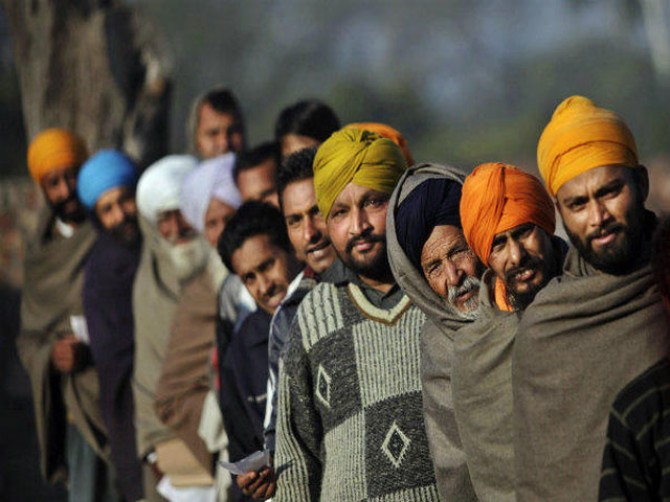New York, USA: A Sikh-American lawyer has urged India to try and live up to its lofty claim of being the “world’s largest democracy” by upholding human rights, especially in Punjab, Kashmir and northeastern states.
Writing in the Christian Science Monitor on the 25th anniversary of one of India’s “darkest, most undemocratic moments” – the suspension of part its constitution to launch a “brutal” campaign against Sikh separatists in Punjab – Sukhman Dhami called for providing reparations to the victims of the onslaught and holding those responsible for the repression “accountable.”
“There is now considerable evidence that many of the same measures that were used to quell dissent in Punjab are consistently being used in Kashmir and the northeast states,” he said in an article published on Saturday. “Both these regions have sought to secede from India, and just like Punjab, their citizens have experienced arbitrary detention, torture, and in some cases unlawful killings and disappearances.”
The writer of the article is a co-founder of Ensaaf, a non-governmental organisation, which investigates the human rights atrocities committed by the Indian government in Punjab.
Dhami wrote, “Twenty-five years ago, on March 30, 1988, India suspended Article 21 of its Constitution, which provides that no person shall be deprived of life or liberty without due process of law. The suspension (of the constitutional article) applied to the northwestern state of Punjab, home to India’s Sikh religious minority and the site of a major secessionist movement that occurred from 1984 to 1995.
“Suddenly, a police officer could arrest, detain, or even summarily execute a citizen of Punjab without judicial accountability. The promise of due process – a guarantee that so many Indians had fought for during the era of independence only decades earlier – had been jettisoned. The results were disastrous. Human Rights Watch and Physicians for Human Rights described the government’s counterinsurgency campaign in India as ‘the most extreme example of a policy in which the end appeared to justify any and all means, including torture and murder.”
While early reports limited the number of deaths to hundreds or the low thousands, our research indicates that nearly 20,000 people were killed, with the peak number of deaths occurring from 1990 to 1993.
“India cannot hide from its past. It must use this anniversary to acknowledge what took place in Punjab, provide reparations to those who were wrongfully harmed, and cease all ongoing human rights violations. By most accounts, the Punjab conflict began in June 1984, when India’s armed forces launched an assault on the Harmandir Sahib complex – popularly known as the “Golden Temple,” the heart of Sikh religious and political life.
The attack began during an important religious holiday, when the complex was overflowing with worshipers, and resulted in several thousand deaths. The government contended that the assault was necessary to flush out militants who had allegedly taken safe harbour inside. However, others claim that the operation was designed to derail a peaceful protest that was expected to attract hundreds of thousands of Sikhs. Many Sikhs believed that the Indian government was discriminating against them and diverting precious resources away from Punjab, and vowed to voice their dissent until the Indian government acquiesced to their demands.
Already feeling persecuted, and now with thousands dead, many Sikhs took up arms. India used all means at its disposal, including police and paramilitary forces, to quell the rebellion. When these efforts met with limited success, India repealed the Constitution’s due process protections for the state of Punjab. Security forces now had the legal cover to target whomever they suspected of participating in the rebellion. Many suspects were picked up by the police and never seen again. In other cases, individuals unconnected to the conflict were targeted to instill fear in the population. And still others were targeted for political purposes, including appeasing police and military officers emboldened by their new found powers.”
“By 1995, the movement had been crushed, and none of the political and economic demands of the Sikhs had been met. Moreover, families in villages throughout Punjab were still searching for relatives who were last seen in police custody. In December 1996, the Indian Supreme Court, relying on an inquiry by India’s Central Bureau of Investigation into mass cremations in Punjab, found a ‘flagrant violation of human rights on a mass scale.’ The court cited evidence that police had secretly cremated more than 2,000 people during the 10-year insurgency. And that was in just one district. Many human rights advocates believe that mass cremations took place in Punjab’s then 12 other districts, as well…”
“To be sure, other states have promulgated special laws and extrajudicial measures to quell insurgencies. One only has to look to the dirty wars of Argentina, Chile, and El Salvador – countries ruled by military juntas at the time – to understand the implications of such policies and practices.”
“What distinguishes India’s case, however, is that it was a functioning democracy when it adopted these measures. Its parliamentarians introduced the amendment as a bill in both houses; the requisite majority voted for the legislation; and the president officially enacted it into law on March 30, 1988. ‘The world’s largest democracy’ had convened to strip the promise of life and liberty, not some military dictator ruling by decree. And it’s clear that India is continuing its abuse of human rights. There is now considerable evidence that many of the same measures that were used to quell dissent in Punjab are consistently being used in Kashmir and the northeast states.
Both these regions have sought to secede from India, and just like Punjab, their citizens have experienced arbitrary detention, torture, and in some cases unlawful killings and disappearances.”
Source: The Nation News
 Sikh Sangat News Celebrating Sikh culture and sharing Sikh voices
Sikh Sangat News Celebrating Sikh culture and sharing Sikh voices

